“Dixie Dingo Dreaming,” the quilt of my dearly departed dog, Pippin, remains one of my favorites. Recently I have had a few students using Australian Aboriginal print fabrics like those in “Dixie Dingo Dreaming,” and lots of students doing portraits of their pets, both of which bring this quilt to mind. It occurs to me that others might like to see how I used these fabrics, with their particular style and motifs, in my quilt. So in keeping with the goal of updating previous blog posts with video, I offer the following.
I don’t suggest that everyone use Aboriginal prints for every fabric collage quilt. In fact, I don’t suggest any style of fabric for every project (okay, maybe printed batiks). Instead, when students are having trouble getting over the hump of choosing which fabrics to start with, I find myself asking them to tell me about their subject. In the case of pets, I may ask them: what are their personalities? Where do they like to hang out? What are their favorite things to do? But most importantly, is there a story behind the subject?
The original blog post (below) gives the whole story of “Dixie Dingo Dreaming,” explaining why I chose the Australian Aboriginal prints in the first place. The new video meanwhile shows how I used the unique features of those Aboriginal fabrics to create the image.
Original Post
Sometimes I wonder if I’m a “serious” artist. I mean, I don’t really worry about it, but it crosses my mind. Anyway, do I really want or need to be a “serious” artist?
And what is “serious” art anyway? I suppose it’s art with a purpose, with an important message, or with a revolutionary way of viewing the world. It tackles important social, political, or philosophical topics. It’s cerebral rather than emotional. It makes you think rather than feel.
Obviously, I don’t believe a word of it. Art can’t be and isn’t bound by such rigid and passionless beliefs. It’s possible and desirable for art to both provoke thought and evoke emotion.
Still, the one thing considered most “unserious” in art may be sentimentality, while its opposite, irony, is nearly worshipped.
By this one measure, then, I am certainly not a “serious” artist. Sentiment literally means feeling. I’m all about feeling, and that trait is reflected, I think, in my quilts, especially those of my family members.

Pippin
“Dixie Dingo Dreaming,” the quilt of my dog, Pippin, is a good example. I didn’t create this quilt in order to make a statement. It is simply a portrait in which I hoped to capture the likeness and character of my beloved pet.
Pippin was a stray in Georgia before being rescued. When I described her to an employee at the local feed and farm store, she replied, “Oh, she’s a Dixie dingo, then.” I’d never heard of them, but a quick Google search and, sure enough, there she was, the native canine of the Americas. Later we came to suspect she had more than a little cattle dog in her, too, but the dingo description followed her for life.
Like many of my quilts, this one had an extended gestation period. I always seem to be setting fabric aside for future quilts. Once I had “dingo” in my mind for Pippin, I made the connection to Australia and to Aboriginal prints. I decided when I did make a quilt of her I would use all Aboriginal-design themed fabrics. For several years, everywhere I went, I was on the lookout for Australian fabrics.
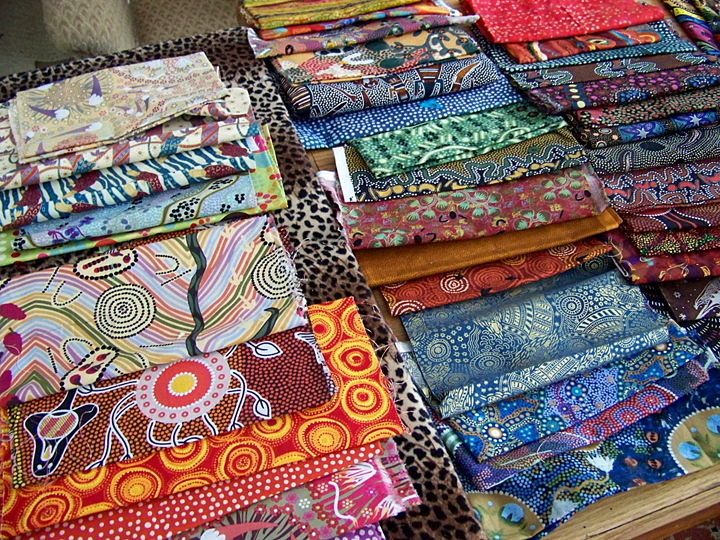
Despite her obvious beauty (!) making a quilt of Pippin wasn’t a priority. Pippin was deep into middle-age when I decided to enter a quilt in the 2011 Houston International Quilt Festival. The theme for that year’s special exhibit was “Good for You.” This particular competition required that the quilt be a new work. It didn’t take long to come up with a justification for how a portrait of Pippin would fit in the “Good for You” theme. Here’s the description that accompanied my entry:
Pets, like our dog Pippin, enrich our lives. The fact that she is not of a breed recognized by the American Kennel Club does not dismay Pippin any more than it does us. She is plainly satisfied to be partly or wholly (who knows for sure?) dixie dingo, the wild dog of the Americas. She reminds us to be happy with who and where we are. Sitting in the sun is an opportunity to practice her philosophy of living in the moment. While correct posture is an important habit to cultivate, it is sometimes preferable, indeed sometimes necessary, to slouch. Simplicity is her touchstone: warmth, food, and affection are all that are really needed. Though on her short list of indulgent behaviors are: begging for dog biscuits, snitching compost scraps, fighting strange dogs, and rolling in anything rotten (either animal or vegetable, it matters not, nor is it always clear). The only thing better than lying in the sun is: sleeping in the sun, of course. Even sitting up her eyes droop and she snoozes, though it is better obviously to stretch out, turning from belly to side to back in order to ensure even distribution of the sun’s rays. Sometimes, when she is lying belly up with legs in the air, her tail will wag, though we have not moved or spoken. Is there any clearer indication that she is happy? Is there any clearer invitation to be happy ourselves?
Making “Dixie Dingo Dreaming”
Pippin had two poses that were typical of her. One was lying with her paws crossed in front of her. This dainty pose belied her ferocious demeanor whenever strangers came to the door, which was less Lady and more Cujo (think bared teeth and flecks of foam). The other pose we later learned is called the cattle-dog slouch. She would sit this way when very relaxed, rear legs splayed out, in a not-very-ladylike way.
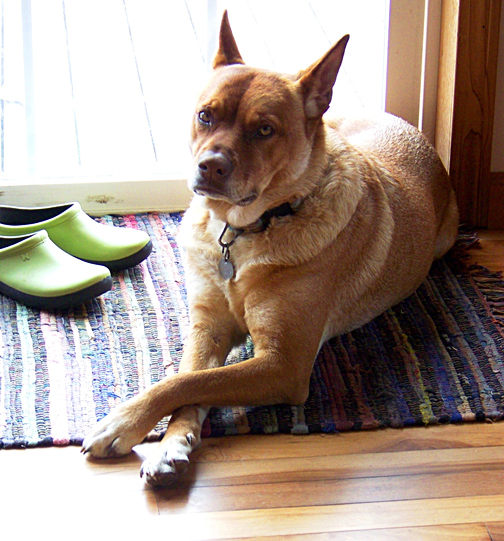
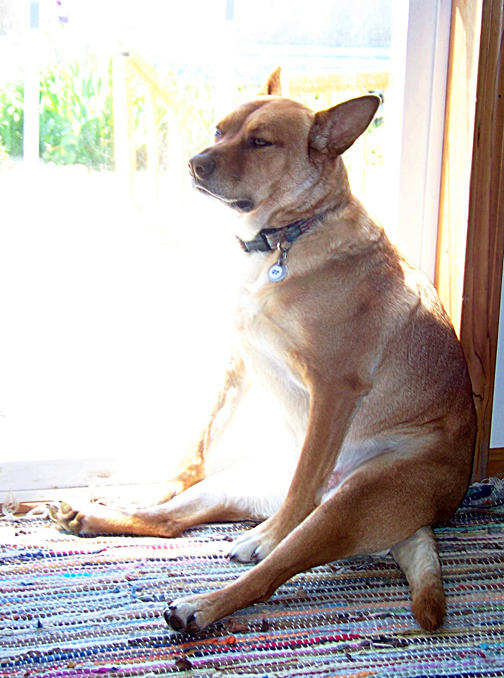
After reviewing my photos I chose the second pose. It was more dynamic (despite the sleepiness evident in her body) and more uniquely her. So as I explained in a previous post, it was time to make a pattern and transfer it to a backing fabric. I wanted her to be life size, so I measured her sitting up and figured out how much to enlarge my outline drawing. The full-size pattern is tiled together from about twelve separate pieces of paper. In this case it was easier to print it out from the computer than run to the copy center.
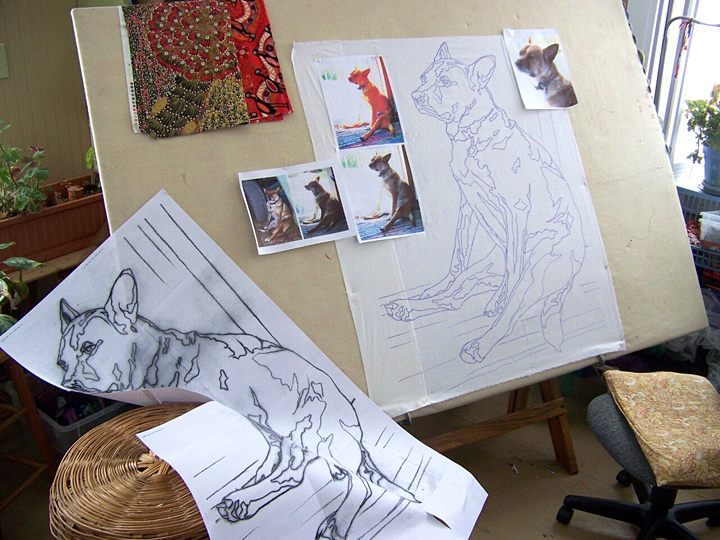
As is my habit, I started with her face. That’s the most interesting part for me, and provides an anchor for me to work out from. If I’m happy with the face, the rest seems easier somehow.
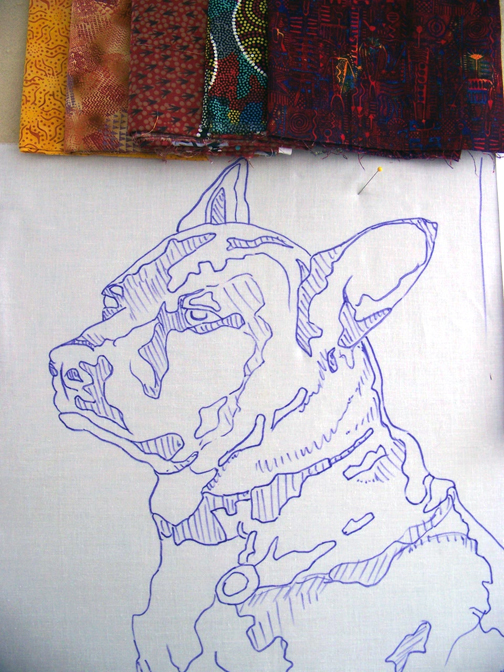
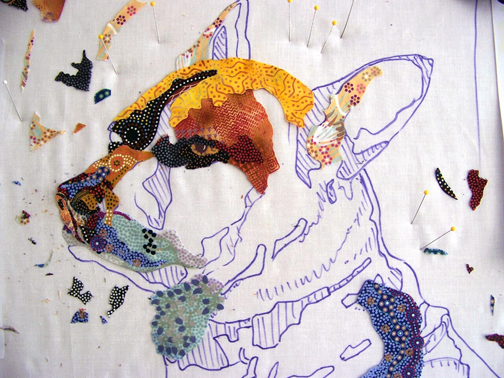
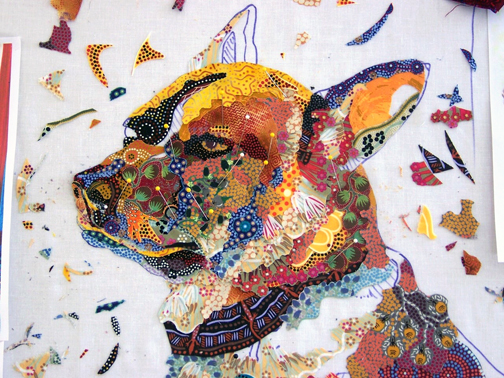
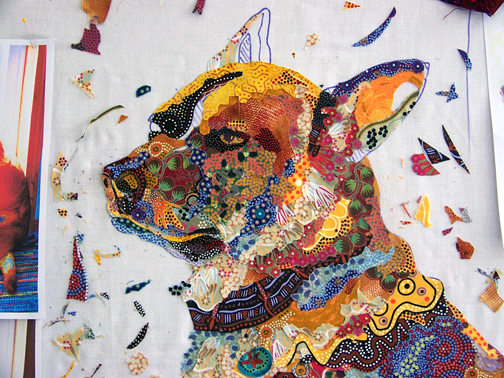
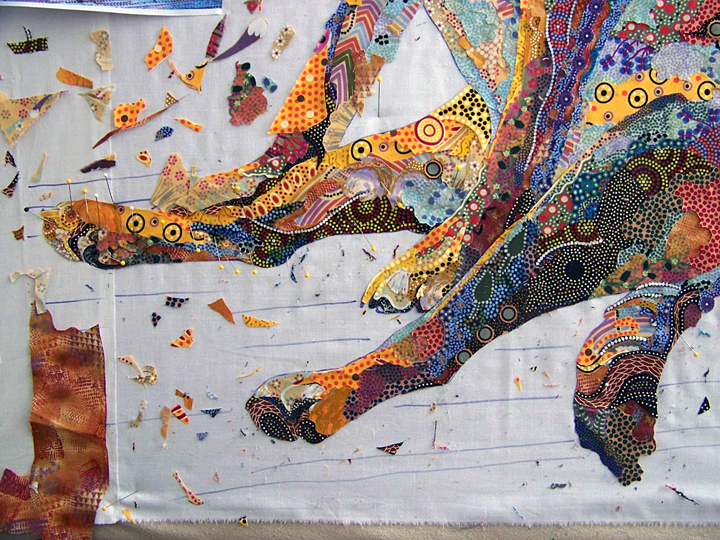
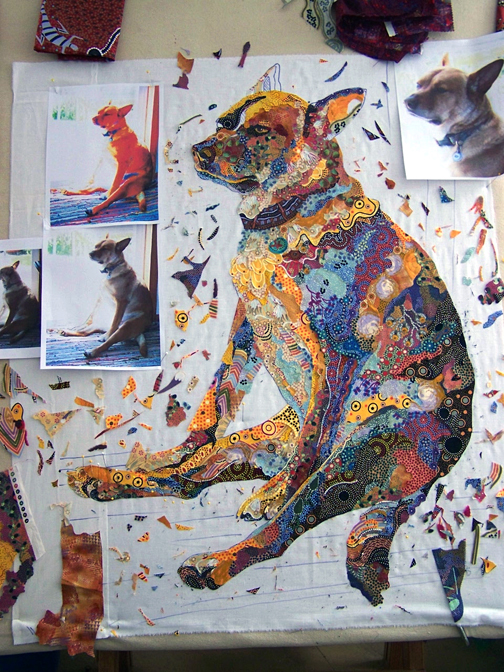
Once I had Pippin almost done. I started to think about backgrounds. At this point, it occurred to me to check the requirements for entry into the “Good for You” competition. Good thing I did. The minimum size for inclusion was 4 x 4 feet. It was lucky I had made Pippin as large as I did, but because she is mostly vertical in format, it meant I would have some width to make up.
Since the photo was of her sitting in the sun, it made sense to include a sun in the composition. In my research, however, I discovered Australian Aborigines didn’t seem to have a symbol for the sun. That would have been the obvious solution. Instead, and luckily, I was forced to create my own sun.

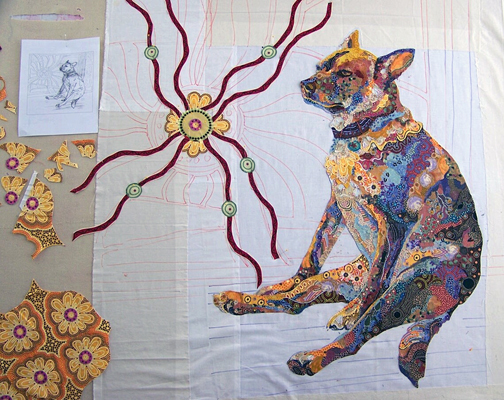
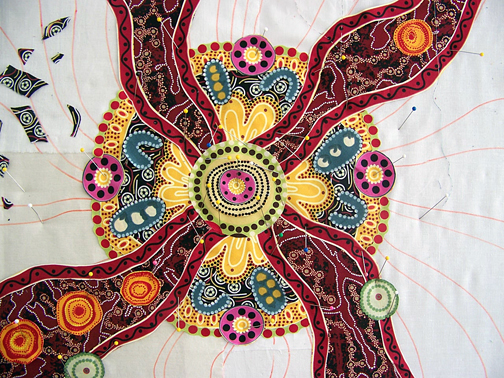
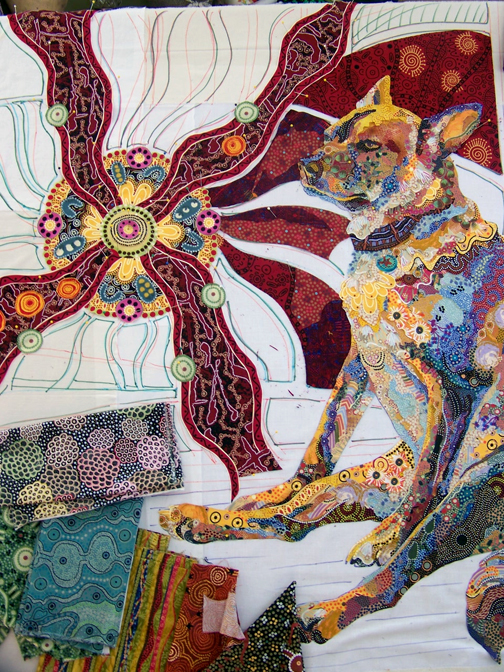
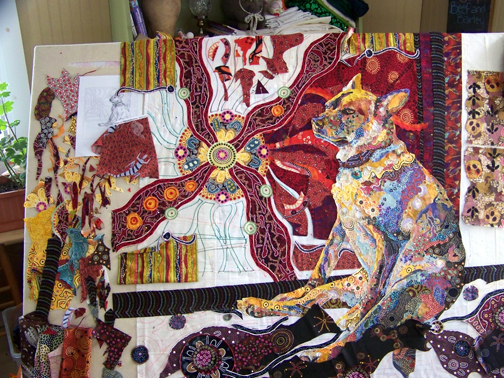
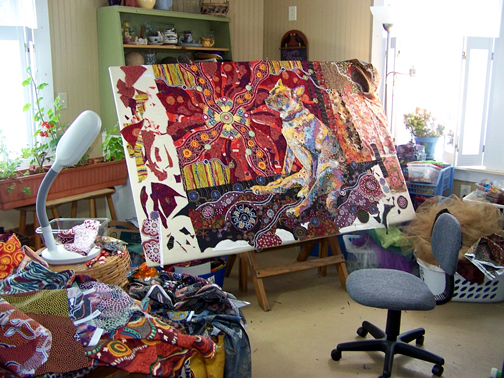
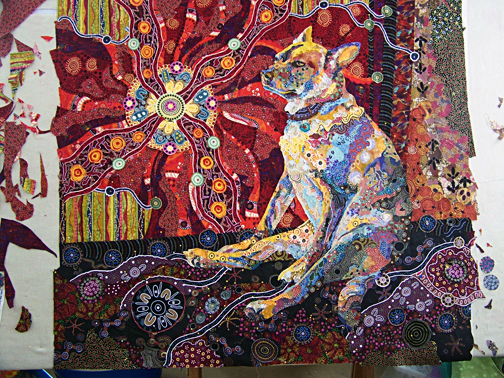
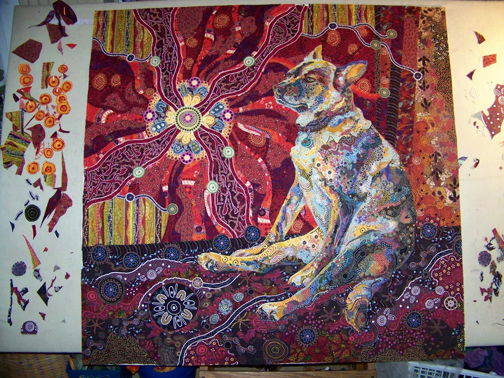
Houston
Not only was “Dixie Dingo Dreaming” accepted into the Houston exhibit, but it won first place in the “Good for You” exhibit. I traveled to Houston to accept the award, accompanied by my mother, Meta. In my short internet biography I say that I am a “long-time student of the Meta Carlson Studio of Fabric Creations,” e.g., my mom’s sewing room. Her strong influence on my life made it especially meaningful to have her there with me.

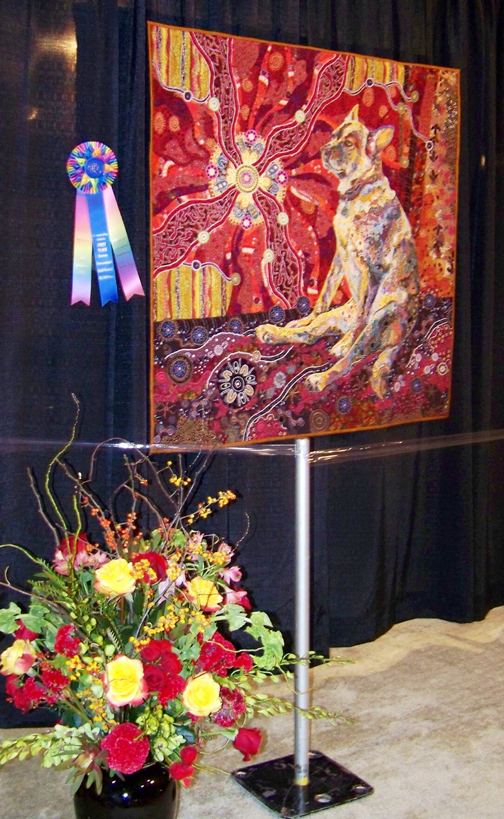
Symbolism
One of the few things I knew about Aboriginal art was that their images have layers of meaning. Unless you’re a part of that culture, you might not be privy to the deeper meaning of these abstracted shapes. However, the more superficial explanations are shared and I used these to create my own story of our own family in the background of the quilt.
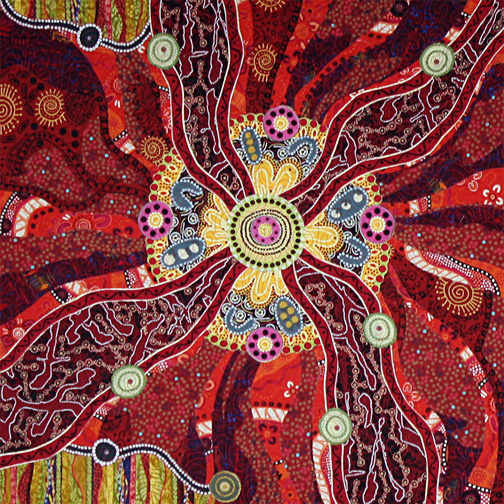
In the very center of the sun, concentric circles of dots represent a campfire in a village, similar to the fire pit in our lawn. Around the campfire are four blue-gray, U-shaped symbols. Those represent tribesmen, or the four of us: me, my husband, our son and the dog. Next to us are ovals with dots in them: baskets of food. There we are, around the campfire sharing a meal.
Wavy lines coming off from the inner circle represent journeys. So there are four main rays, one for each of us, that represent each of our journeys in life. When a smaller circle intersects one of the rays, that represents a pause in the journey. Someone pointed out to me that one of those journeys has two stops on it. “Well that must be your dog’s journey,” she said. Why? “She was someplace else before she came to you. So that’s hers. You became the second pause in her journey.”
The black and white horizontal wavy lines throughout the piece represent the journey of our cat Max, because he was an independent soul who wandered in and out of our lives, mostly coming in only for food and warmth, then wanting to be let back out.
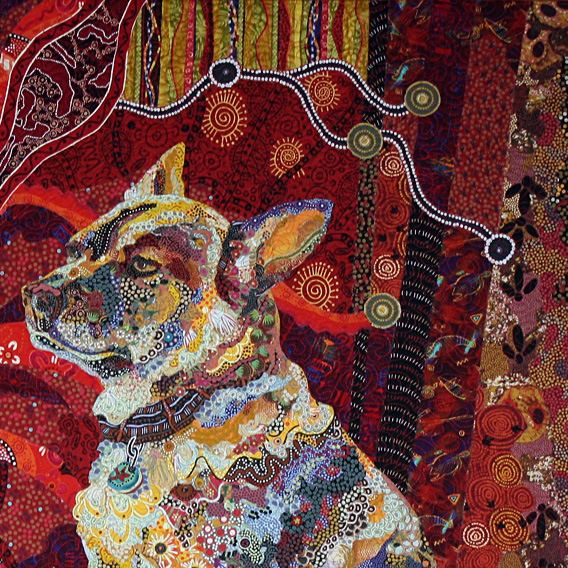
On the far right you see bird prints, which are supposed to be emu prints, but in our case represent our budgie Kiiora’s prints, which finishes the members of our family at that time. Not only are there footprints, but also eggs because she has laid dozens of (unfertilized) eggs in her lifetime.
So you see, “Dixie Dingo Dreaming” is a portrait of our dog, but it is also the story of our family at that time.
Serious Art
Does the sentiment on display (and hidden in its private symbols) in “Dixie Dingo Dreaming” prevent it from being “serious art”? I don’t know, but I do know that removing the sentiment from this piece, if you could do such a thing, would diminish it. I made it with love and when I look at it I remember the love Pippin gave me. I think that is clear to just about everybody who sees the piece.
Personally, I prefer art with heart. It takes guts for any artist, whether professional or novice, to lay out his or her feelings for others to examine, pore over, and critique. It takes courage to express sentiment, while it’s possible to hide behind being flip, detached, and ironic.
There was no irony in Pippin. She gave life her all. She devoured every biscuit she was offered. She tried to dominate every dog she met. She enjoyed every sunbeam and belly rub.
I call that serious art.

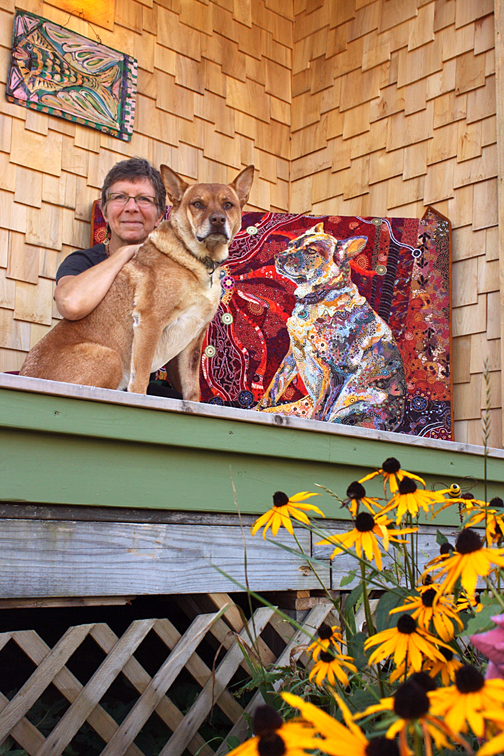
Love, love, love your story and all the meaning/love that went into this quilt. I very much enjoy and learn from your posts. Thanks for all you share with us.
This is a beautiful story in quilt form. It is definitely serious art, but I love the term art with a heart because so much love from you and Pippin shows through your quilt. She was a lucky dog to have found a home with you! Ann
Thank you for sharing Pippin s story.
Reading this post w/tears in my eyes & a smile on my lips. By invoking an emotional response … THAT is art!
Art isn’t art without heART. The richness of your story translated into fabric is the mark of a true artist. I love reading your posts and thank you for sharing your heart and process.
What a beautiful tribute to Pippin with a beautiful portrait and story!! Thanks for sharing, Susan!
A stunning tribute to a beloved family member. Every piece so lovingly chosen for its significance to the whole. Thank you for sharing your story and the journey to this beautiful work of art.
such a wonderful story behind your awesome quilt – quilts with such meaning are always so special 🙂
oh and thanks so much for your fabulous information in the video on how you picked the fabrics for this quilt !
Fabulous work Susan. Thanks so much for sharing your journey, it’s very helpful. I look forward to starting something early next year.
Dixie dingo is amazing and what a tribute to him….
I want to try my hand at this but need to know if you place bridal netting over the
Entire picture and then do quilted stitches over it?….
I rea
I am a great fan of yours Susan
I love how you tell the story of Pippin while explaining how you created this quilt. Your writing is as fascinating as your fabric creations. Thank you.
Thanks for sharing your beautiful story with us and how this work of art evolved. I love your work.
I loved this post, it made me cry thinking of my dogs. But there is joy as well. I just found out yesterday that my name on the wait list for the first week of class at the Quilt Gallery in Kalispell became available AND I bought several aborigine prints at my local quilt store yesterday as well! A lady asked me ‘what are you going to do with these?’ I said I really don’t know yet; I will just have to wait until they tell me what they want me to do with them. Thank you for the timely inspiration!
Thank you for this post and all of them. I learn so much just watching and listening to your techniques in collage.